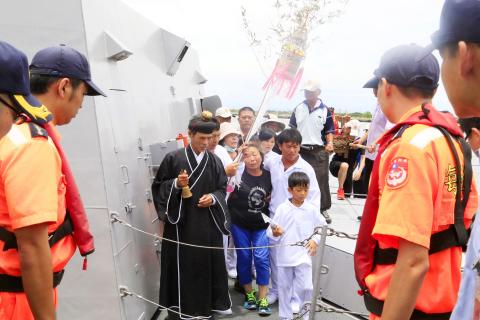The Ministry of National Defense on Saturday issued a detailed news release to debunk a string of conspiracy theories surrounding the launch of a missile on Friday last week, that resulted in the death of a Taiwanese fisherman and three injuries.
The release started by asking how a noncommissioned officer could be allowed to “do it alone” without receiving the consent of his superiors.
The ministry said the warship’s commander, senior arms officer and missile launch control sergeant had all failed to follow standard operating procedure before the sailor chose the wrong operation mode, committing a series of disciplinable mistakes that resulted in the historic fiasco.

Photo: CNA
The ministry said it had learned a tough lesson from the mishap, adding that from next week, it would enforce stricter training programs for all military units, particularly in the area of standard operating procedures, to prevent a similar incident from occurring.
Regarding whether it was appropriate for the armed forces to conduct a live-fire training exercise while President Tsai Ing-wen (蔡英文) was on a foreign visit, the ministry said the corvette was not participating in a “military drill,” but rather a “test of training results.”
As to why sailors on the vessel did not initiate the Hsiung Feng III missile’s “self-destruct” system, the ministry said the mechanism is only installed in missiles during formal military exercises and, as the crew was not participating in such an exercise, that option was unavailable.
In response to rumors that Petty Officer, Second Class Kao Chia-chun (高嘉駿) “exulted” after launching the missile, the statement said: “No, our investigation found that to be untrue.”
Another rumor was that Kao showed no remorse over his actions and posted some remarks on Facebook and played games after the incident.
The ministry said Kao’s mobile phone was immediately confiscated and examined, and no evidence was found to support such speculation.
“The rumor is false,” it added.
Regarding why the navy did not send any ships or aircraft to the scene after the incident, with only Coast Guard Administration vessels seen on site, the ministry said the navy dispatched two corvettes, four speedboats and two helicopters to search for the missile and immediately contacted the coast guard for assistance in recovery efforts.
The ministry also rejected reports that an ammunition ship was preparing to enter the harbor when the missile was mistakenly launched.
The missile was designed to attack military vessels, and as the structure of fishing boats tends to be lighter and weaker, the impact lacked the strength to detonate the warhead, the ministry said in response to why the missile did not explode.
In response to an allegation by Lu Li-shih (呂禮詩) — the former commander of a Chinchiang-class corvette, the same type of warship involved in the incident — that the launch occurred because control procedures for the missile’s launch key were not properly followed, the ministry said the Hsiung Feng III does not have a launch key, and therefore no control procedures were needed.
The ministry said it deeply regretted Lu’s “mistaken” and “misleading” comments about the case.

Taiwan is to commence mass production of the Tien Kung (天弓, “Sky Bow”) III, IV and V missiles by the second quarter of this year if the legislature approves the government’s NT$1.25 trillion (US$39.78 billion) special defense budget, an official said yesterday. Commenting on condition of anonymity, a defense official with knowledge of the matter said that the advanced systems are expected to provide crucial capabilities against ballistic and cruise missiles for the proposed “T-Dome,” an advanced, multi-layered air defense network. The Tien Kung III is an air defense missile with a maximum interception altitude of 35km. The Tien Kung IV and V

The disruption of 941 flights in and out of Taiwan due to China’s large-scale military exercises was no accident, but rather the result of a “quasi-blockade” used to simulate creating the air and sea routes needed for an amphibious landing, a military expert said. The disruptions occurred on Tuesday and lasted about 10 hours as China conducted live-fire drills in the Taiwan Strait. The Civil Aviation Administration (CAA) said the exercises affected 857 international flights and 84 domestic flights, affecting more than 100,000 travelers. Su Tzu-yun (蘇紫雲), a research fellow at the government-sponsored Institute for National Defense and Security Research, said the air

A strong continental cold air mass is to bring pollutants to Taiwan from tomorrow, the Ministry of Environment said today, as it issued an “orange” air quality alert for most of the country. All of Taiwan except for Hualien and Taitung counties is to be under an “orange” air quality alert tomorrow, indicating air quality that is unhealthy for sensitive groups. In China, areas from Shandong to Shanghai have been enveloped in haze since Saturday, the ministry said in a news release. Yesterday, hourly concentrations of PM2.5 in these areas ranged from 65 to 160 micrograms per cubic meter (mg/m³), and pollutants were

Taiwan’s armed forces have established response protocols for a wide range of sudden contingencies, including the “Wan Chun Plan” to protect the head of state, the Ministry of Defense (MND) said today. After US President Donald Trump on Saturday launched a series of airstrikes in Venezuela and kidnapped Venezuelan President Nicolas Maduro, concerns have been raised as to whether China would launch a similar “decapitation strike” on Taiwan. The armed forces regularly coordinate with relevant agencies and practice drills to ensure preparedness for a wide range of scenarios, Vice Minister of National Defense Hsu Szu-chien (徐斯儉) told reporters before a